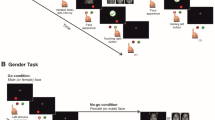Abstract
Extracting mental and task performance state-information from a human in real time is a challenging scientific endeavour. In this paper, we attempt to understand if there is a relationship between the frontal cortex activities in the F3 and F4 positions according to the 10-20 international system of electrode placement, which are known to correlate with executive control functions and working memory, and facial muscle activities. We demonstrate that in a highly demanding control, planning and problem solving task, as the human gets more engaged in the task, there is a consistent increase of correlation between the frontal cortex activities, an anti correlation between the cheeks and forehead muscles, and that the two correlations are perfectly anti-correlated with each other. The results suggest a resource shifting occurring during the task as the task progresses and the complexity of the task increases.
Access this chapter
Tax calculation will be finalised at checkout
Purchases are for personal use only
Preview
Unable to display preview. Download preview PDF.
Similar content being viewed by others
References
Jasper, H.H.: The Ten Twenty Electrode System of the International Federation. Electroencephalogr. Clin. Neurophysiol. 10, 371–375 (1958)
Tan, D., Nijholt, A.: Brain-Computer Interfaces and Human-Computer Interaction. In: Tan, D.S., Nijholt, A. (eds.) Brain-Computer Interfaces, pp. 3–19. Springer, London (2010)
Norman, D.A., Bobrow, D.G.: On Data-Limited and Resource-Limited Processes. Cognitive Psychol. 7, 44–64 (1975)
Craik, K.J.W.: Theory of the Human Operator in Control System1. The Operator as an Engineering System. Brit. J. Psychol. General Section 38, 56–61 (1947)
Moray, N.: Where is Capacity Limited? A Survey and a Model. Acta Psychologica 27, 84–92 (1967)
Welford, A.T.: Single-Channel Operation in the Brain. Acta Psychologica 27, 5–22 (1967)
Wickens, C.D.: Multiple Resources and Performance Prediction. Theor. Issues Ergon. Sci. 3, 159–177 (2002)
Locke, E.A., Shaw, K.N., Saari, L.M., Latham, G.P.: Goal Setting and Task Performance: 1969–1980. Psychol. Bull. 90, 125–152 (1981)
Bandura, A.: Self-efficacy Mechanism in Human Agency. American Psychologist 37, 122–147 (1982)
Locke, E.A., Frederick, E., Lee, C., Bobko, P.: Effect of Self-efficacy, Goals, and Task Strategies on Task Performance. J. Appl. Psychol. 69, 241–251 (1984)
Greene, B.A., Miller, R.B.: Influences on Achievement: Goals, Perceived Ability, and Cognitive Engagement. Contemporary Educational Psychol. 21, 181–192 (1996)
Gerloff, C., Corwell, B., Chen, R., Hallett, M., Cohen, L.G.: Stimulation over the Human Supplementary Motor Area Interferes with the Organization of Future Elements in Complex Motor Sequences. Brain 120, 1587–1602 (1997)
Buzsáki, G., Anastassiou, C.A., Koch, C.: The Origin of Extracellular Fields and Currents — EEG, ECoG, LFP and Spikes. Nat. Rev. Neurosci. 13, 407–420 (2012)
Herwig, U., Satrapi, P., Schönfeldt-Lecuona, C.: Using the International 10-20 EEG System for Positioning of Transcranial Magnetic Stimulation. Brain Topogr. 16, 95–99 (2003)
Rossi, S., Cappa, S.F., Babiloni, C., Pasqualetti, P., Miniussi, C., Carducci, F., Babiloni, F., Rossini, P.M.: Prefontal Cortex in Long-Term Memory: an “Interference” Approach Using Magnetic Stimulation. Nat. Neurosci. 4, 948–952 (2001)
Gevins, A., Smith, M.E., McEvoy, L., Yu, D.: High-Resolution EEG Mapping of Cortical Activation Related to Working Memory: Effects of Task Difficulty, Type of Processing, and Practice. Cereb. Cortex 7, 374–385 (1997)
Dimberg, U.: Facial Reactions to Facial Expressions. Psychophysiology 19, 643–647 (1982)
Weiss, S., Mueller, H.M.: The Contribution of EEG Coherence to the Investigation of language. Brain Lang. 85, 325–343 (2003)
Clarke, A.R., Barry, R.J., Heaven, P.C.L., McCarthy, R., Selikowitz, M., Byrne, M.K.: EEG Coherence in Adults with Attention-Deficit/Hyperactivity Disorder. Int. J. Psychophysiol. 67, 35–40 (2008)
Dunning, D., Heath, C., Suls, J.M.: Flawed Self-Assessment. Psychol. Sci. Public Interest 5, 69–106 (2004)
Langendyk, V.: Not Knowing that They Do not Know: Self-assessment Accuracy of Third-Year Medical Students. Med. Educ. 40, 173–179 (2006)
Author information
Authors and Affiliations
Editor information
Editors and Affiliations
Rights and permissions
Copyright information
© 2012 Springer-Verlag Berlin Heidelberg
About this paper
Cite this paper
Ren, S., Barlow, M., Abbass, H.A. (2012). Frontal Cortex Neural Activities Shift Cognitive Resources Away from Facial Activities in Real-Time Problem Solving. In: Huang, T., Zeng, Z., Li, C., Leung, C.S. (eds) Neural Information Processing. ICONIP 2012. Lecture Notes in Computer Science, vol 7666. Springer, Berlin, Heidelberg. https://doi.org/10.1007/978-3-642-34478-7_17
Download citation
DOI: https://doi.org/10.1007/978-3-642-34478-7_17
Publisher Name: Springer, Berlin, Heidelberg
Print ISBN: 978-3-642-34477-0
Online ISBN: 978-3-642-34478-7
eBook Packages: Computer ScienceComputer Science (R0)




